A contractor’s first installation of Aquatherm brings 21st century pipe to a 1925 structure There is a first time for everything, and that includes contractors installing Aquatherm pipe. Aquatherm is the industry leader in training and support, but for a contractor there’s still nothing quite like successfully completing that first project. For Service Tech Inc Read more
Featured

A contractor’s first installation of Aquatherm brings 21st century pipe to a 1925 structure
There is a first time for everything, and that includes contractors installing Aquatherm pipe. Aquatherm is the industry leader in training and support, but for a contractor there’s still nothing quite like successfully completing that first project.
For Service Tech Inc., a heating and air conditioning firm in Birmingham, AL, that is celebrating its 30th year in business in 2020, its first experience installing Aquatherm came at a historic landmark building in Birmingham.
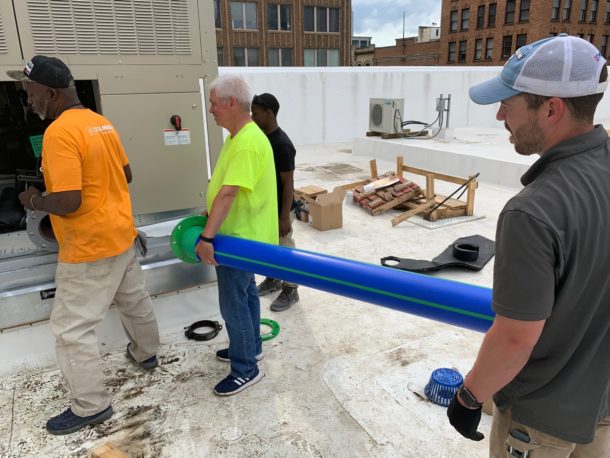
The light weight of Aquatherm pipe makes it easy to handle and maneuver, and eases the weight load on the building’s roof.
At the risk of a “spoiler,” how did the project go?
“It was great, man,” said Brandon Henley, Operations Manager at Service Tech. “Everyone on the installation team was impressed with how well-engineered the Aquatherm pipe was and how easy it was to work with.”
THE MAGIC CITY
Birmingham was founded in 1871, the result of a merger of three farm towns. It didn’t remain a farm town for long. It grew so rapidly between 1880 and 1920 that it earned the nickname “The Magic City.” In the process it became a primary industrial center of the southern United States based on mining, iron, and steel. More recently it has become one of the largest banking centers in the South.
Today Birmingham is the largest city in Alabama and is the seat of Jefferson County, which is Alabama’s most populous.
Since 1925, the city’s skyline has been graced by the 10-story, 120-ft New South Federal Savings Building. The art deco structure originally featured a brick and terra cotta façade; its current Texas granite and white Alabama marble façade was installed during a renovation completed in 1959.

The 10-story New South Federal Savings Building has been a part of the Birmingham skyline since 1925.
The building’s first two floors have been occupied for many years by a banking tenant, but the building recently took on a new life when the United States Census Bureau chose to make it the area office for the 2020 U.S. census. To prepare for this new tenant it was necessary to rehabilitate four of the building’s floors, including replacement of its old heating and cooling system.
OUT WITH THE OLD
The building’s owner decided to do away with the old system of rooftop units, and invest in a new (and much more efficient) chiller-based system. This meant installing pipe in places where there hadn’t previously been pipe.
The firm of Zgouvas, Eiring, & Associates, Consulting Engineers, chose to spec Aquatherm pipe for the new chiller system at the New South Federal Savings Building. The firm specified the polypropylene pipe because of its safety profile when working in an existing (and occupied) building.
“I thought it would be easier to work with because you wouldn’t have to be welding steel pipe in the building,” explained Jay Eiring, a partner in the firm. “I proposed it to the building owner and he gave us the green light to proceed.”
The project began in February 2019 and was completed in May 2019. It ultimately called for approximately 5,000 ft of ½-in. through 6-in. SDR 11 Aquatherm Blue Pipe® MF.
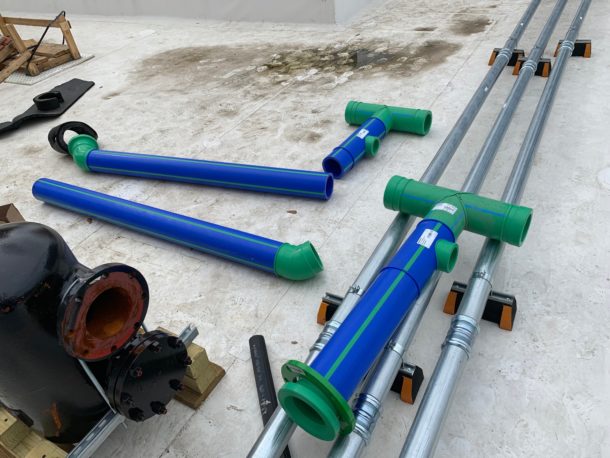
Custom piping assemblies fabricated on site by Service Tech Inc. at the New South Federal Savings Building.
TOUGH CHALLENGES
The project came with its share of challenges. The installing contractor had to work in very tight quarters because of the building’s age and the fact that the original mechanical chases weren’t designed to accommodate hydronic piping. Some of the piping itself had to be relocated to exterior walls because of site constraints. To add to the fun, the chases that the pipe needed to run through were filled with the building’s electrical and telephone wiring. Finally, the incoming government tenant wanted to get the office up and running quickly, resulting in a compressed timeline.
These challenges would have been significant no matter how experienced the installation team was. For first-time Aquatherm installers Service Tech, however, the combination of Aquatherm training and support, the product’s inherent ease of use, and strong local support from Ferguson Enterprises helped the installation go smoothly and successfully. Ferguson is the largest wholesale distributor of residential and commercial plumbing supplies and pipe, valves, and fittings in the U.S.
“We had eight of our technicians trained by Aquatherm, and Ferguson’s support throughout the project was great,” Henley said. “Anything we needed from Ferguson they delivered, all we had to do was ask.”
SAFE AND FAST CONNECTIONS
Henley noted that while welding steel pipe would have been dangerous in the tight quarters of an existing, occupied building, all the connections with Aquatherm were made safely thanks to reliable heat fusion, which creates virtually leak-free connections without welding, sparks, or open flame.
The Aquatherm installation also went much faster than welding steel. During installation it wasn’t unusual for Service Tech to have two McElroy Spider™ 125 fusion machines and two socket fusion irons in use at the same time.
“After we completed the training we were really feeling good about doing the heat fusions ourselves,” Henley said.
Ferguson stepped in to fabricate (on site in one day) the 6-in. lines from the chiller, which connected to the 3-in. and 4-in. lines Henley and the Service Tech team were installing throughout the building.
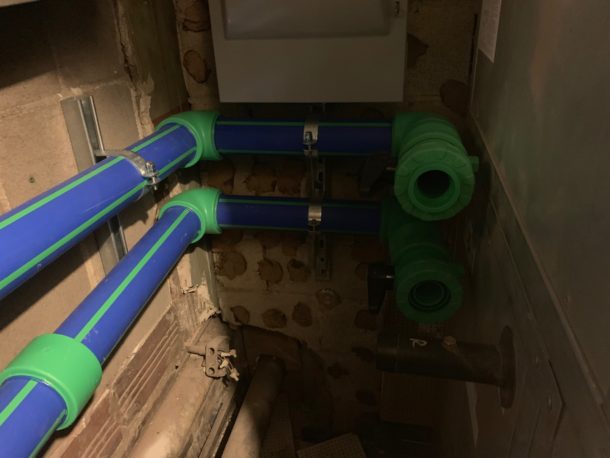
Brand-new Aquatherm pipe in place in the nearly 100-year-old chases at the New South Federal Savings Building.
LIGHT WEIGHT AND CLEAN
The light weight of Aquatherm pipe earned rave reviews from Henley and his crew. He noted that this project was very labor-intensive: Service Tech had to remove 16 old rooftop condensing units along with all of their refrigerant piping, replace the old air-handling units with new hydronic fan coils units, install the new Daikin 200-ton air-cooled chiller on the building’s roof, and pipe the system. In most cases piping the system may have been the most difficult part, but after all the other heavy lifting on this project Service Tech’s crew found Aquatherm pipe to be a pleasure to work with.
“One person could pick up a 19-foot length of three-inch Aquatherm pipe and carry it to the next floor,” he added. “There’s no way someone would be able to that with three-inch cast iron or steel pipe. And the light weight was a huge factor where the pipe had to be relocated to the building’s exterior walls.”
Henley’s crew also appreciated the cleanliness of the Aquatherm pipe compared to steel pipe, and he noted that once the system was up and running the pipe’s resistance to rust, scaling, and corrosion added to the system’s ease of operation and maintenance.
“We barely had to use any kind of corrosion-resistant additives in the chiller water,” Henley noted.
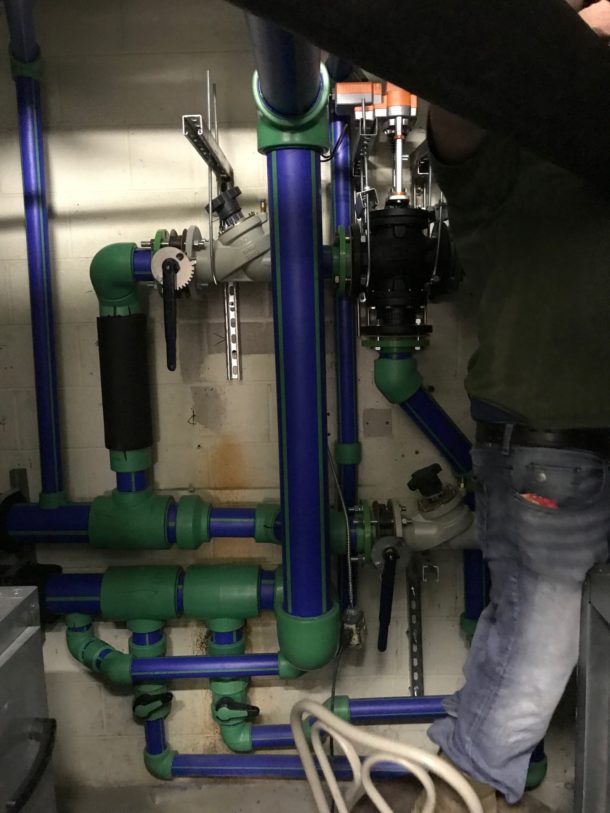
This impressive installation was the first Aquatherm installation done by Service Tech Inc.
A SUCCESSFUL FIRST PROJECT
Jeff Long, Southeast District Product Manager, Ferguson Enterprises, noted that this project represents a first-time Aquatherm contractor successfully field-fabricating and installing a complete system on a complex project.
“That speaks well for both Service Tech’s personnel and the ease of working with Aquatherm pipe,” he said.
Eiring added that Aquatherm is a natural choice for existing buildings.
“It’s easy to work with, it’s lightweight, and there’s no welding on site,” he said. “And Aquatherm’s 10-year warranty is something a building owner definitely doesn’t get with steel pipe.”
Summing up his company’s first experience with Aquatherm, Henley said it was the pipe’s toughness that impressed him the most.
“It was so much more durable than I initially thought,” he said. “After working with it I’m convinced that pipe will still be there even after the building is gone.”
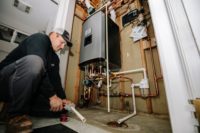
As you read this, thousands of American families are considering a move to less densely populated areas. Towns and cities within the Rocky Mountain States – Idaho, Montana and Wyoming specifically – are seeing unprecedented population growth. The idea of living in rural and suburban areas is gaining a lot of interest among residents of Read more
As you read this, thousands of American families are considering a move to less densely populated areas.
Towns and cities within the Rocky Mountain States – Idaho, Montana and Wyoming specifically – are seeing unprecedented population growth. The idea of living in rural and suburban areas is gaining a lot of interest among residents of the country’s more populated regions.
Popular opinion in these scenic areas attribute the migration to three major factors: social unrest in urban areas, prevalence of COVID-19 cases, and the ability for more people to telecommute, professionally.
The owner of a moving company in Cody, WY, noted that they had relocated a dozen families from California in May alone. Real estate prices are rising, counter to what would be expected during a recession. Similar stories come from Montana.
“A customer of mine who is a real estate agent just sold a $700,000 home sight unseen to a family from back East,” said Andy Mickelson, owner of Mickelson Plumbing and Heating Inc. in Missoula, MT. “He took them through the home via Skype just before a contract was signed. Migration is extreme. Houses are selling fast, and high.”

Earlier this year, the same real estate agent referred a recent homebuyer to Mickelson for boiler replacement. Not surprisingly, the house was purchased in a hurry.
“The homeowner ran out of domestic hot water a week after buying the home, so we replaced the igniter on the mod-con boiler which was supplying heat to an indirect tank,” said Mickelson. “We also found that the heat exchanger had failed, so we returned to replace the boiler as soon as we could.”
Mickelson is a Montana native who started his own company in 2011, after 13 years at a large mechanical firm. Today he employs two full time technicians and has the work for more – if only he could find the right people. He’s a self-proclaimed wet-head, but his skill set also includes commercial controls, plumbing and air conditioning.
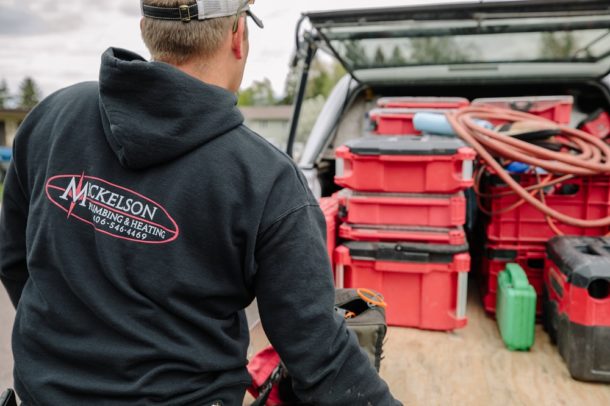
While Mickelson’s work can be seen in commercial buildings and full-blown mountainside mansions (he’s done work for some of the world’s most famous musicians), this specific home was average in every way.
Smart components
The 2,500-square-foot bi-level was constructed in the 80s, and the aluminum-block condensing boiler he found in the house was, to his knowledge, boiler number two. Installing boiler number three, a 199 MBH Aspen Combi made by U.S. Boiler Company, would have been pretty straightforward if not for several messy system changes that had been done in the past.
“The system was a result of 30 years of additions and haphazard corrections,” explained Mickelson. “At one point a water softener had been added, and an irrigation system was tee’d into the domestic piping. On top of that, the first retrofit was a hack job.”

At least the three zones of fin-tube baseboard were in good condition; one downstairs and two upstairs. By the time he started to cut the supply and return piping out of the closet mechanical room, he already had a plan for the new system.
“I pair a heat load calculation with a radiation measurement,” said Mickelson. “This not only tells me the supply water temperatures I’ll need for proper outdoor reset programming, but it gives me the flow and head I’ll need out of my system pump. This is valuable information to optimize comfort and efficiency with two components I used on this job.”
“A Taco 0018e circulator allows me to precisely set my flow rate for a 20°F Delta-T, and paired with U.S. Boiler’s Sage Zone Control, the pump will respond perfectly as zones open and close.”
Without the help of a buffer tank, the Sage Zone Control allows the boiler to start at low fire and only increase to the firing rate needed for the zone (or zones) calling. Mickelson inputs the size of all three zones, and the boiler fires accordingly, never exceeding the actual load, and the ECM circulator responds by modulating the flow rate across the system.
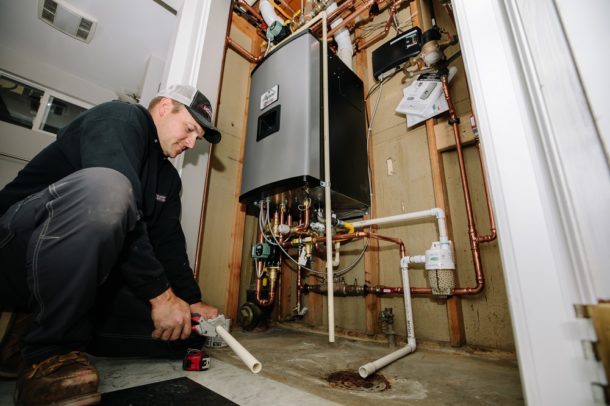
“A single circulator with baseboard and zone valves is perfect for this setup,” said Mickelson. There’s never a concern about being over- or under-pumped. This house needs about five feet of head and five GPM with all zones open.”
“Both the Sage Zone Control and the 0018e are very easy to program,” he explains. “The panel is accessible through the boiler’s Sage Control, which is connected to the boiler via a CAT 5 cable. I access the pump via a Bluetooth app on my phone. It has a number of different modes; constant speed, proportional pressure, and constant pressure, as well as a self-adjusting proportional pressure mode.”
The perfect fit
For simplicity and space savings, Mickelson installed the Aspen Combi instead of adding an indirect tank. The house only has two occupants, so there’s never a concern of running more than two showers at a time.
Connections to the combi boiler were very easy to make from the bottom side of the unit, even in the cramped closet. Adjusting the burner for Missoula’s 3,200 foot elevation was simple. The factory-supplied exhaust fitting has a built-in test port for a combustion analyzer, and the boiler cabinet has a side access panel for easy access to the gas valve.
“Taco’s mobile app for Bluetooth connection to the circulator makes changing modes, etc., very easy, and all feedback from the Aspen boiler and the Sage Zone Panel read out in plain English on the boiler’s touchscreen display,” said Mickelson. “I didn’t need a secret decoder ring to set the unit up.”
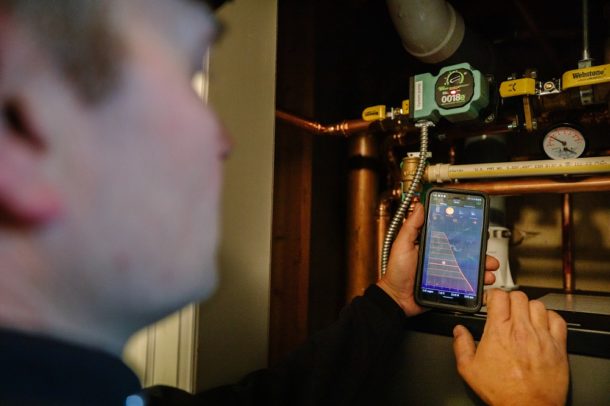
The homeowner’s frustration at buying a property that immediately needed a new boiler came at least with a silver lining. The new system is comfortable and reliable. Ignition is smooth, and the loudest noise that the system makes is the baseboard heating up. That’s a very good thing, considering that the mechanical closet is adjacent to the owner’s home office.
As working from home in the Rocky Mountains becomes more popular, the mechanical contractors who’re best suited to provide the right solutions will benefit while western towns grow.
